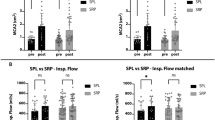Abstract
Purpose
Gagging may be a challenge in daily otorhinolaryngology (ORL) routine. This cross-sectional study aimed to examine conditions of gagging as limitation to ORL examination and the efficacy of acupressure as tool to reduce exaggerated gagging.
Methods
The study was conducted on a total of 360 study subjects. There was a survey part and a routine ORL examination with observation of gagging behaviour. Through binomial univariate logistic regression, predictors of clinically relevant exaggerated gagging were identified. Wilcoxon signed rank test was used to evaluate efficacy of acupressure point CV-24 to reduce gagging while examination.
Results
First gagging’s relevance was indicated by over 40% of study subjects showing clinically relevant exaggerated gagging. Furthermore, we found that more psychogenic than somatogenic features proved to be predictors of exaggerated gagging. Third acupressure point CV-24 showed statistical significant reduction of gagging intensity and improved examination feasibility.
Conclusion
Awareness of exaggerated gagging’s predictors are the first step to deal with gagging in daily practice. Acupressure might be an effective tool to overcome gagging in the affected patients.
Level of evidence
We suggest at least Level IV according to Oxford (UK) CEBM Levels of Evidence.


Similar content being viewed by others
References
Dickinson C (2000) Gagging problems in dental patients: literature review for the diploma in dental sedation. GKT Dental Institute of King’s College London
Dickinson CM, Fiske J (2005) A review of gagging problems in dentistry: I. Aetiology and classification. Dent Update 32(1):26–32
Hearing CM, Bind RH, Tabacco MJ, Hallock RM (2014) A reliable and valid survey to predict a patient’s gagging intensity. J Oral Maxillofac Res 5(2):e3. https://doi.org/10.5037/jomr.20014.5203
Linden Van, van den Heuvell GF, Ter Pelkwijk BJ, Stegenga B (2008) Development of the gagging problem assessment: a pilot study. J Oral Rehabil 35(3):196–202. https://doi.org/10.1111/j.1365-2842.2007.01774.x
Bassi GS, Humphris GM, Longman LP (2004) The etiology and management of gagging: a review of the literature. J Prosthet Dent 91(5):459–467. https://doi.org/10.1016/S0022391304000939
Hoad-Reddick G (1986) Gagging: a chairside approach to control. Br Dent J 161(5):174–176. https://doi.org/10.1038/sj.bdj.4805922
Conny DJ, Tedesco LA (1983) The gagging problem in prosthodontic treatment. Part II: patient management. J Prosthet Dent 49(6):757–761
Krol AJ (1963) A new approach to the gagging problem. J Prosthet Dent 13(4):611–616. https://doi.org/10.1016/0022-3913(63)90131-8
Kramer RB, Braham RL (1977) The management of the chronic or hysterical gagger. ASDC J Dent Child 44(2):111–116
Rosted P, Bundgaard M, Fiske J, Pedersen AM (2006) The use of acupuncture in controlling the gag reflex in patients requiring an upper alginate impression: an audit. Br Dent J 201(11):721–725. https://doi.org/10.1038/sj.bdj.4814305 (discussion 715)
Rosler A, Otto B, Schreiber-Dietrich D, Steinmetz H, Kessler KR (2003) Single-needle acupuncture alleviates gag reflex during transesophageal echocardiography: a blinded, randomized, controlled pilot trial. J Altern Complement Med 9(6):847–849. https://doi.org/10.1089/107555303771952190
Samsoon GL, Young JR (1987) Difficult tracheal intubation: a retrospective study. Anaesthesia 42(5):487–490
Mallampati SR, Gatt SP, Gugino LD, Desai SP, Waraksa B, Freiberger D, Liu PL (1985) A clinical sign to predict difficult tracheal intubation: a prospective study. Can Anaesth Soc J 32(4):429–434
Dickinson CM, Fiske J (2005) A review of gagging problems in dentistry: 2. Clinical assessment and management. Dent Update 32(2):74–80
Wright SM (1981) Medical history, social habits, and individual experiences of patients who gag with dentures. J Prosthet Dent 45(5):474–478
Holm S (1979) A simple sequentially rejective multiple test procedure. Scand J Stat 6(2):65–70
van Houtem CM, van Wijk AJ, Boomsma DI, Ligthart L, Visscher CM, de Jongh A (2015) Self-reported gagging in dentistry: prevalence, psycho-social correlates and oral health. J Oral Rehabil 42(7):487–494. https://doi.org/10.1111/joor.12289
Randall CL, Shulman GP, Crout RJ, McNeil DW (2014) Gagging and its associations with dental care-related fear, fear of pain and beliefs about treatment. J Am Dent Assoc 145(5):452–458. https://doi.org/10.14219/jada.2013.50
Hornby PJ (2001) Central neurocircuitry associated with emesis. Am J Med 111(Suppl 8A):106S–112S
Hainsworth JM, Hill KB, Rice A, Fairbrother KJ (2008) Psychosocial characteristics of adults who experience difficulties with retching. J Dent 36(7):494–499. https://doi.org/10.1016/j.jdent.2008.03.011
Vachiramon A, Wang WC (2002) Acupressure technique to control gag reflex during maxillary impression procedures. J Prosthet Dent 88(2):236
White A, Editorial Board of Acupuncture in M (2009) Western medical acupuncture: a definition. Acupunct Med 27(1):33–35. https://doi.org/10.1136/aim.2008.000372
Vachiramon A, Wang WC, Vachiramon T (2004) The use of acupuncture in implant dentistry. Implant Dent 13(1):58–64
Aickin M, Gensler H (1996) Adjusting for multiple testing when reporting research results: the Bonferroni vs Holm methods. Am J Public Health 86(5):726–728
Acknowledgements
We say thank you to Jakob Schöpe, M.Sc., Department of Medical Biometrics, Epidemiology and Medical Informatics, Saarland University Medical Centre, as consulted statistician.
Author information
Authors and Affiliations
Corresponding author
Ethics declarations
Conflict of interest
The authors declare that they have no conflict of interest.
Research involving human participants and/or animals
This study is based on research involving human participants. This article does not contain any studies with animals performed by any of the authors.
Ethical approval
All procedures performed in this study involving human participants were in accordance with the ethical standards of the institutional and/or national research committee and with the 1964 Helsinki declaration and its later amendments or comparable ethical standards (Identification number of the Institutional Review Board: 167/13).
Informed consent
Informed consent was obtained from all individual participants included in the study.
Additional information
Publisher's Note
Springer Nature remains neutral with regard to jurisdictional claims in published maps and institutional affiliations.
German Otorhinolaryngology Annual Meeting “Würgereiz bei Untersuchungen von Mundraum und Pharynx: strukturierte Beurteilung, Prävalenz, Ursachen und seine mögliche Supprimierbarkeit durch den Akupressurpunkt CV-24“, Phillip Kulas, David Zuschlag, Bernhard Schick, Dietmar Hecker, Alessandro Bozzato; published Mars 30th 2016 at “87. Jahresversammlung der Deutschen Gesellschaft für Hals-Nasen-Ohren-Heilkunde, Kopf- und Hals-Chirurgie e. V.”, Mai 4th to 7th 2016, Düsseldorf; https://doi.org/10.3205/16hnod025, urn:nbn:de:0183-16hnod0254.
Electronic supplementary material
Below is the link to the electronic supplementary material.
Rights and permissions
About this article
Cite this article
Zuschlag, D., Kulas, P., Schick, B. et al. The gagging patient in ORL examinations: predictors, evaluation and treatment. Eur Arch Otorhinolaryngol 276, 1775–1781 (2019). https://doi.org/10.1007/s00405-019-05404-w
Received:
Accepted:
Published:
Issue Date:
DOI: https://doi.org/10.1007/s00405-019-05404-w




